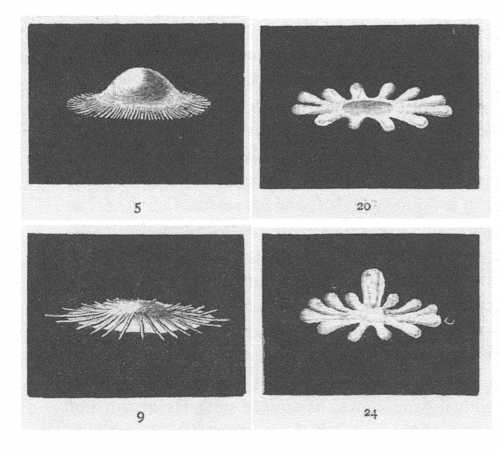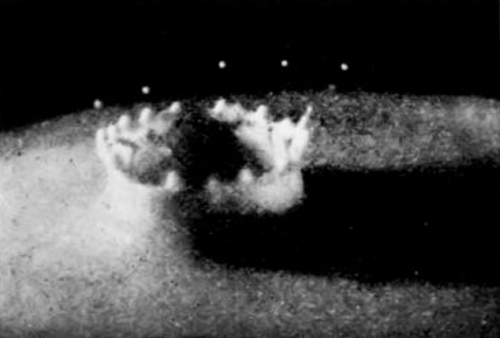Carlo Benvenuto

2/5
Figure 1 – Arthur M. Worthington, “Splash of a Drop”, A Study of Splashes, London: Longmans, Green

3/5
Time after contact = 0262 sec. Figure 2 – Arthur Worthington, The Splash of a Drop, London: Society for Promoting Christian Knowledge 1895 p. 6, The Online Books Page, Project Gutenberg
The Water Drop Effect
British physicist Arthur Worthington (1852–1916) was carrying out experiments investigating the splash of a drop of fluid since 1875. His perception of the event – and the subsequent annotations he carefully made, preserved in the Royal Society Archives – indicated regularity in the effects of the splash: tiny drops would form in a symmetrical way. ‘For Worthington himself, the subject had always been, as he endlessly repeated, a physical system marked by the beauty of its perfect symmetry.’ 1
As Lorraine Daston and Peter Galison point out, scientists often set out to capture the world in its types and regularities, not peculiarities, in order to more clearly fulfill a perfect description of the world.2 For almost twenty years, according to Worthington’s system, there was no possibility of anything other than order, balance, symmetry. Why was all this time spent on observing a splash? The answer to this question is provided by Mr. Worthington himself:
The splash of a drop is a transaction which is accomplished in the twinkling of an eye, and it may seem to some that a man who proposes to discourse on the matter for an hour must have lost all sense of proportion. If that opinion exists, I hope this evening to be able to remove it, and to convince you that we have to deal with an exquisitely regulated phenomenon, and one which very happily illustrates some of the fundamental properties of fluids.3
It was only in 1894 that he was eventually able to photograph the instant of a splash of water into fluid – milk. The result suddenly contradicted decades of careful observation: an explosion of chaos and entropy.
The vision he had held up until that point was heavily contested: ‘Thus the mind of the observer is filled with an ideal splash — an Auto-Splash —whose perfection may never be actually realized.’4 He also noted that ‘it is impossible to put together the drawings so as to tell a consecutive story, without being guided by some theory’ 5, basically declaring that he was seeing only what he wanted to see. Worthington also noted that:
The reason that with ordinary continuous light nothing can be satisfactorily seen of the splash, is not that the phenomenon is of such short duration, but because the changes are
so rapid that before the image of one stage has faded from the eye the image of a later and quite different stage is superposed upon it. Thus the resulting impression is a confused assemblage of all the stages, as in the photograph of a person who has not sat still while the camera was looking at him.6
Carlo Benvenuto’s research shows several connections with Worthington’s ways of proceeding. To Benvenuto, the choice of photography is as ineluctable as the impending photograph of 1894 was to Worthington: ‘it can in a fraction of a second produce an image. The one printed on the film will be definitive and irrevocable.’7 Analog photography indeed denies possibilities, affirming one, and only one, possible reality. Thus, what is revealed in Benvenuto’s work is exactly the opposite of Worthington’s discoveries: ultimate perfection, balance, harmony and symmetry inhabit his world. Photographs are used to describe what is not visible at first sight: a suspended architectural metaphysics where shadows and chaos are rarely seen, a magical realism. But there are no tricks or postproduction at work: editing, angles and lighting are decided in the moment of the shoot. His subjects, when captured by the camera, become perfection, a not easily visible purity, indeed, ‘painting and drawing are like seeing with the eyes, while photography is seeing with the mind’.8
Worthington’s obsession – ‘the splash of a drop which is accomplished in the twinkling of an eye’ – might seem, as the same physician describes, something infinitesimal and irrelevant to everybody else. The same applies to Benvenuto, whose entire corpus and objects of interest remain in the intimacy of his house in Stresa.
Particularly inspiring are the words of Paul Valery regarding the relationship between word and image, literature and photography. No matter how excellent a writer, how could he describe, for example, a face in such a way that it would not suggest as many envisionings as there are readers?9 Photographs, and Valery uses the example of the passport image, identify unequivocally the features of a person, in such precision words could never reach. How does the work of Benvenuto relate to this? The table, a constant architectural feature of his photographs, changes dramatically in each image, and it is able to take on different forms in the mind of the observer, becoming an intimate element, a different table for every person that is looking. Magically, the table loses all its characteristic connotations, becoming every table that has ever existed, a transcendental element. Thus, the powers of photography of unmistakable identification fall short. Benvenuto indeed is not reproducing reality, rather including it in his work, avoiding, by always keeping the scale one-to-one, any form of optical, human distortion: ‘The estrangement is produced regularly when you become aware of something, it is produced whenever you add an element to your awareness of the world, you must inevitably update your thinking and deal with the new intruder.’10 Some similarities seem to exist within the work of David Hammons, of which Dawoud Bey has noted that he ‘is committed to creating works of art that exist in their own right; in their own time and space. Some of us may never see them. In fact, most of us won’t. Yet the sense of myth created by the unseen is one of Hammons’ concerns.’11
Time within the photographs is indistinguishable, but it seems the same, day by day, photograph after photograph, much like the age of their subjects, whose futures coincide with their past, photographs which also do not seem to be exposed to the process of aging. What would an archaeologist do in 1000 years, trying to reproduce the house in Stresa, where Benvenuto has been taking these pictures? Would an anthological exhibition be able to reveal the interiors of the house, as well as the atmosphere that governs it? What about the non-material realities, as Valery reminds us – ‘photography accustomed the eyes to wait for what they must see, and therefore to see it; and instructed them not to see what does not exist’?12
While photography seems to bring the object close to us, taming its extraneity, including it in an ideal taxonomy of the photograph, in Benvenuto’s work, objects become untouchable. Benvenuto’s work requires an immanent space; a human who, in a necessity similar to Worthington’s observations, is able to sit still in front of them for a long time in order not to see.
1 Lorraine Daston and Peter Galison, Objectivity, New Yok, Zone Books 2007, p. 11.
2 Ibidem.
3 Arthur Worthington, The Splash of a Drop, London: Society for Promoting Christian Knowledge, 1895, p. 1.
4 Ivi, p. 58.
5 Ivi, pp. 74-75.
6 Ibidem
7 Carlo Benvenuto, “La fotografia è uno specchio che riflette sem- pre la stessa immagine” in Fermo Immagine, a cura di Spenuso e Mezzocut-mis, Mimesis, Sesto San
Giovanni 2008, translated by the author, orig: “nella natura specifica della fotografia; essa permette in una frazione di secondo di pro- durre un’immagine. Quella impres- sa sulla pellicola sarà definitiva e irrevocabile”.
8 Carlo Benvenuto in a private conversation with the author, 10 of January 2019.
9 Paul Valery, Discorso sulla fotogra- fia, a cura di Raffaele Lucariell, Filema Edizioni, 2005, Italiano con testo francese, p. 2.
10 Carlo Benvenuto, in “Le cose del mondo”, interview by Massimiliano Gioni, published on ..., access on 16 February 2018 at http://www. trax.it/carlo_benvenuto.htm,
translation by the author (“Lo stra- niamento si produce regolarmente quando si prende coscienza di qualche cosa, si produce ogni qual- volta si aggiunge un elemento alla propria consapevolezza del mondo, inevitabilmente bisogna aggiornare il proprio pensiero e fare i conti con il nuovo intruso”).
11 Dawoud Bey, “David Hammons: Purely an Artist”, Uptown, 1982, p.16.
12 Paul Valery, Discorso, cit., orig: “La photographie accoutuma les yeux à attendre ce qu’ils doivent voir, et donc à le voir; et elle les instruisit à ne pas voir ce qui n’existe pas”, p. 20.
galleriamazzoli.com

2/5
Figure 1 – Arthur M. Worthington, “Splash of a Drop”, A Study of Splashes, London: Longmans, Green

3/5
Time after contact = 0262 sec. Figure 2 – Arthur Worthington, The Splash of a Drop, London: Society for Promoting Christian Knowledge 1895 p. 6, The Online Books Page, Project Gutenberg


